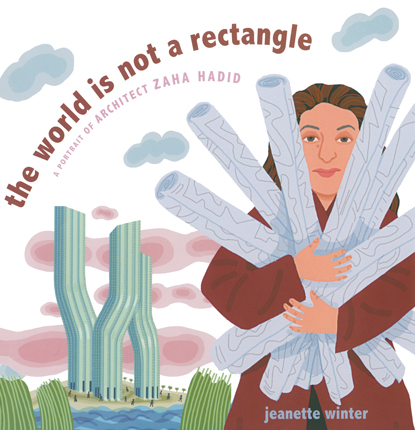Full Text Reviews: Booklist - 07/01/2017 *Starred Review* Iranian architect Zaha Hadid drew inspiration for her designs from the natural world, which she famously stated “is not a rectangle.” As a result, her buildings swoop, curve, twist, and flow. Winter opens with an overview of Zaha’s childhood and education, paying particular attention to the ruins, deserts, and marshes she visited with her father during her youth, because these are the sites that sparked her passion for design and her unique style. Winter does an excellent job of utilizing double-page spreads to link several of Zaha’s famous buildings with the object or vista upon which they were modeled. A simple seashell transforms into a sports stadium; marsh grasses inspire a cluster of kinked apartment towers; the galaxy’s whirling stars are reflected in a building’s curves and swirls. Winter’s illustrations utilize cool pastel tones and seamlessly integrate Zaha’s buildings—and later her fashion and furniture designs—with nature, perfectly reflecting the architect’s organic design philosophy. Readers will also come away with a firm sense of Zaha’s tenacity and determination as she refuses to be held back by her ethnicity, gender, or unconventional ideas. The book closes with a guide to the buildings featured in the story, noteworthy quotes from Zaha, and a short bio. A fantastically crafted picture-book biography of a woman deserving of recognition. - Copyright 2017 Booklist. School Library Journal - 07/01/2017 Gr 1–5—Even as a child, Zaha Hadid was fascinated by the landscapes and ruins of her native Iraq, seeing patterns in them she later repeated in her urban designs. Her unusual ideas prompted her to study architecture in London and eventually open Studio 9, an office in which she and her colleagues designed unconventional buildings that epitomized her mantra, "The world is not a rectangle." Despite criticism and setbacks, Hadid's belief in the impossible led to commissions to design a museum, an opera house, a stadium, and even a ski jump, which incorporated their surrounding landscapes into the core of their structures. When she died in 2016, Hadid had the distinction of being the only woman to receive both the Pritzker Prize and the Royal Gold Medal for her inventive sense of design. From its catchy title to the clear depiction of its extraordinary subject, this book will appeal to elementary students, particularly those craving daring role models. The simple text flows as easily as Hadid's ideas, and Winter's painterly acrylic illustrations are its perfect complement, bringing to life a rather stern artist intent on realizing her artistic visions against all odds. Art teachers can use the endpapers' portrayals of Hadid's unusual structures to help students create their own landscape-inspired designs, and mention of her Iraqi heritage could prompt discussions on global artists. VERDICT Ripe with ties to curricula, this is a great choice for art and biography collections.—Nancy Menaldi-Scanlan, formerly at LaSalle Academy, Providence - Copyright 2017 Publishers Weekly, Library Journal and/or School Library Journal used with permission. Loading...
|



